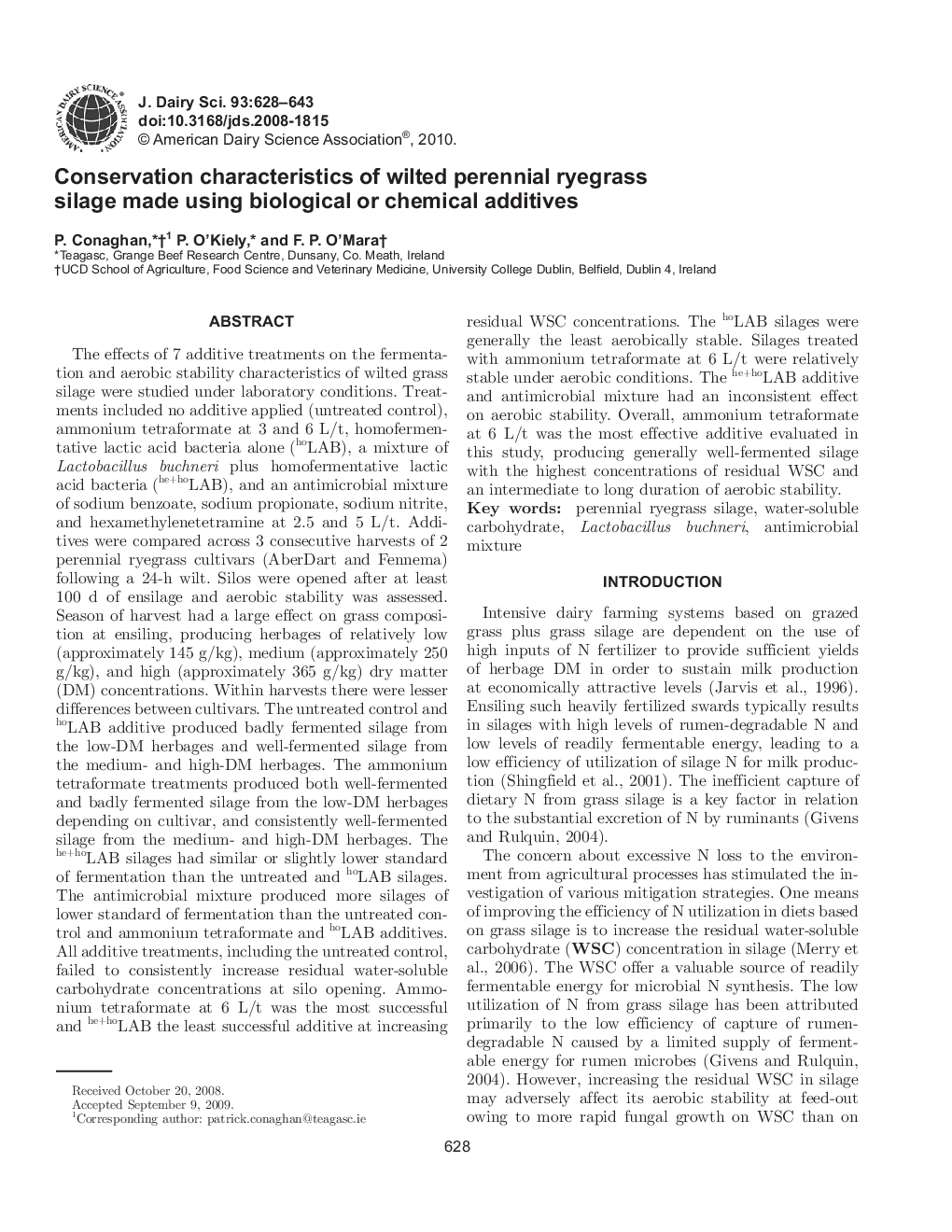| کد مقاله | کد نشریه | سال انتشار | مقاله انگلیسی | نسخه تمام متن |
|---|---|---|---|---|
| 5789779 | 1108084 | 2010 | 16 صفحه PDF | دانلود رایگان |
عنوان انگلیسی مقاله ISI
Conservation characteristics of wilted perennial ryegrass silage made using biological or chemical additives
دانلود مقاله + سفارش ترجمه
دانلود مقاله ISI انگلیسی
رایگان برای ایرانیان
موضوعات مرتبط
علوم زیستی و بیوفناوری
علوم کشاورزی و بیولوژیک
علوم دامی و جانورشناسی
پیش نمایش صفحه اول مقاله

چکیده انگلیسی
The effects of 7 additive treatments on the fermentation and aerobic stability characteristics of wilted grass silage were studied under laboratory conditions. Treatments included no additive applied (untreated control), ammonium tetraformate at 3 and 6 L/t, homofermentative lactic acid bacteria alone (hoLAB), a mixture of Lactobacillus buchneri plus homofermentative lactic acid bacteria (he+hoLAB), and an antimicrobial mixture of sodium benzoate, sodium propionate, sodium nitrite, and hexamethylenetetramine at 2.5 and 5 L/t. Additives were compared across 3 consecutive harvests of 2 perennial ryegrass cultivars (AberDart and Fennema) following a 24-h wilt. Silos were opened after at least 100 d of ensilage and aerobic stability was assessed. Season of harvest had a large effect on grass composition at ensiling, producing herbages of relatively low (approximately 145Â g/kg), medium (approximately 250Â g/kg), and high (approximately 365Â g/kg) dry matter (DM) concentrations. Within harvests there were lesser differences between cultivars. The untreated control and hoLAB additive produced badly fermented silage from the low-DM herbages and well-fermented silage from the medium- and high-DM herbages. The ammonium tetraformate treatments produced both well-fermented and badly fermented silage from the low-DM herbages depending on cultivar, and consistently well-fermented silage from the medium- and high-DM herbages. The he+hoLAB silages had similar or slightly lower standard of fermentation than the untreated and hoLAB silages. The antimicrobial mixture produced more silages of lower standard of fermentation than the untreated control and ammonium tetraformate and hoLAB additives. All additive treatments, including the untreated control, failed to consistently increase residual water-soluble carbohydrate concentrations at silo opening. Ammonium tetraformate at 6 L/t was the most successful and he+hoLAB the least successful additive at increasing residual WSC concentrations. The hoLAB silages were generally the least aerobically stable. Silages treated with ammonium tetraformate at 6 L/t were relatively stable under aerobic conditions. The he+hoLAB additive and antimicrobial mixture had an inconsistent effect on aerobic stability. Overall, ammonium tetraformate at 6 L/t was the most effective additive evaluated in this study, producing generally well-fermented silage with the highest concentrations of residual WSC and an intermediate to long duration of aerobic stability.
ناشر
Database: Elsevier - ScienceDirect (ساینس دایرکت)
Journal: Journal of Dairy Science - Volume 93, Issue 2, February 2010, Pages 628-643
Journal: Journal of Dairy Science - Volume 93, Issue 2, February 2010, Pages 628-643
نویسندگان
P. Conaghan, P. O'Kiely, F.P. O'Mara,